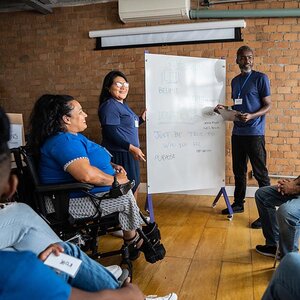Giving rates fell across all racial, ethnic groups over 18 years

Giving rates to all types of charities, including religious organizations, decreased among all racial and ethnic groups studied over an 18-year span, but there were variations in the timing and extent of these declines, according to a report from the Indiana University Lilly Family School of Philanthropy finds.
The report, The Giving Environment: Giving Trends by Race and Ethnicity (50 pages, PDF), found that decline in giving rates among communities of color can be partially attributed to economic factors, including recessions, and placed overall giving rates in two categories: pre-recession (2000-08) and post-recession (2008-18). Before the recession, the most substantial drop in overall giving rates was observed in American Indian households—a decline of 11 percentage points, which after the recession narrowed to 7 percentage points, making it the smallest decrease among racial and ethnic groups. Overall giving by Asian American households before the recession rose 8 percentage points, the most out of all groups. After the recession, Asian American giving declined by 21 percentage points, the most significant reduction after Hispanic Americans, who experienced a 23-percentage point decrease.
The report is part of the school’s Everyday Donors of Color and The Giving Environment research series, which addresses the “declining donors” phenomenon, focusing on economic factors such as wealth and income, religious affiliation, and other demographics, as well as trust in individuals and institutions, help explain the charitable behavior of donors of color.
The Giving Environment report is supplemented by a second study, The Speed of Trust: An Experiment Examining the Effect of Trust on Giving among Members of Diverse Racial/Ethnic Groups (22 pages, PDF), which explores whether awareness that a charitable organization is highly trusted by others affected that donor’s willingness to donate to that charity and/or to give directly to a person in need. The report found that knowing that a nonprofit organization is highly trusted influenced people’s likelihood of giving to the organization, but the advantage of the “high-trust” over the “low-trust” nonprofit condition was moderated by the participant’s race/ethnicity. According to the report, when it comes to giving directly to those in need, race/ethnicity had more influence over giving decision to an individual than a nonprofit’s trust level who worked directly with the affected population.
“By better understanding the diverse practices and long-term giving trends of donors of color, both donors and nonprofit organizations gain valuable insights on ways they can come together to achieve shared goals,” said Lilly Family School of Philanthropy associate dean for research and international programs Una Osili. “Engaging donors of color in culturally relevant and appropriate ways [is] critical to increasing philanthropic participation and fostering a more inclusive and equitable society.”
(Photo credit: Getty Images/FG Trade)








